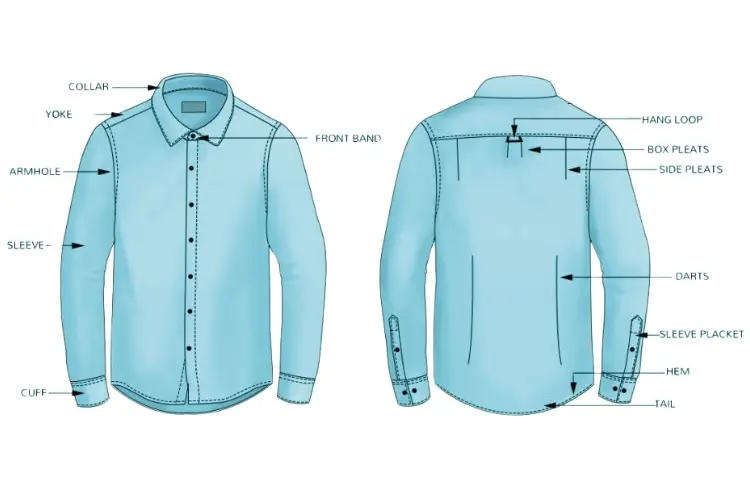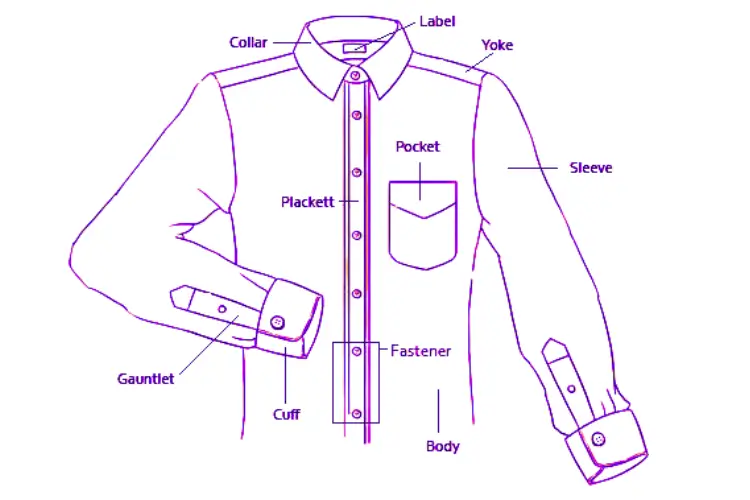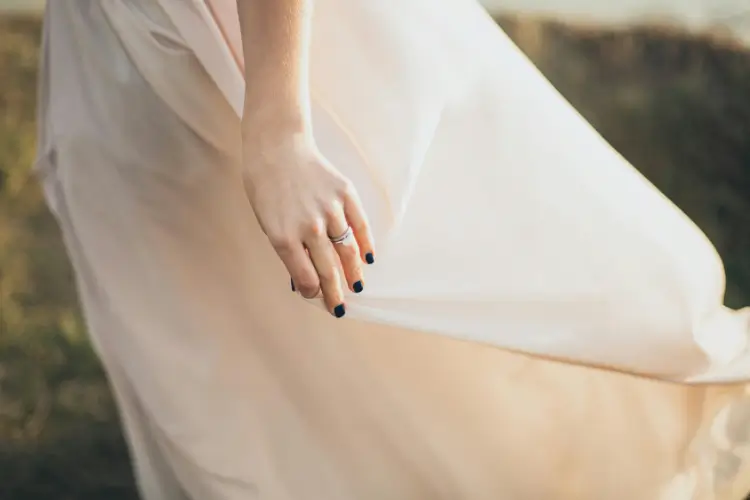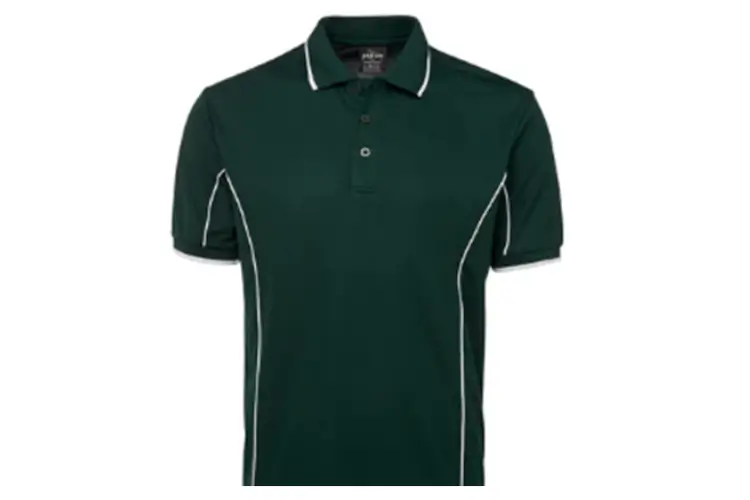A shirt, a fundamental piece of clothing, is composed of several distinct components that contribute to its overall design and functionality. Understanding the 15 different parts of a shirt, such as the collar band, labels, placket, buttons, sleeves, armhole, cuffs, chest pocket, hem, back pleats, and darts, helps appreciate the craftsmanship involved in shirt making. Each part of a shirt, from the collar to the hem, plays a crucial role in ensuring comfort, style, and durability. The collar, for instance, not only defines the shirt’s formal appearance but also provides a comfortable fit around the neck. Meanwhile, the yoke and side seams ensure the shirt fits well across the shoulders and body, allowing for ease of movement.
There are several components to a shirt which makes it a basic piece of clothing. A shirt consists of the following components:
Pars of a Shirt
There are several components to a shirt which makes it a basic piece of clothing. A shirt consists of the following components:
1. Collar
A piece of material that covers the neck and is folded behind the neck is known as collar. It’s a crucial consideration for men in particular when looking for the perfect shirt to finish off their desired look. Every collar contains collar bands on both the front and back of the shirt collar, halfway up the front. When it comes to measuring a men’s shirt, neck or collar size is used. Common collar styles include the traditional Point collar, the laid-back Button-down collar, the adaptable Spread collar and the unfolded stand-up Mandarin collar.
2. Collar Band/Collar Stand
One of the vital aspects contributing to the overall construction of a shirt collar is the collar band which is the platform for collar development around the neck. Its purpose is to give the shirt collar some rigidity by encircling the back of the shirt. While it is possible that the breadth and material of this collar band will differ from the design and style of the shirt, the collar band’s function will always be the same. This helps ensure that the collar remains well-positioned and maintains the form it requires, which optimizes drape and comfort in the suit. To enhance the collar points and have them firmly attached to the collar band, there can be buttonholes, loops or darts hence enhancing the appearance of the shirt collar.
3. Labels
The shirt label can be viewed as a small strip of fabric located either on the collar or on the side of the garment and containing useful information. Typically, such labels contain the trade mark, the size, the fabric composition, washing and ironing instructions and the country of manufacture. Conceptual symbolism includes; brand labels identify the manufacturer of the shirt as well as confer a certain level of identity and prestige. Customers can use such labels to determine the right size of a shirt.
4. Yoke
Yoke refers to the measurement that extends across the chest in some shirts and extends back to the upper portion of the back. Usually composed of one or more pieces of fabric. The yoke pattern can differ: this particular piece may be one entire piece that goes from the shoulder to the shoulder ‘Single Yoke’ or it may be in sections that are seamed together ‘Split Yoke’ with a seam in the center back. The primary function of a shirt yoke as utilized in the case of the envisaged shirt is to give some room for movement while at the same time ensuring that the garment fits well over the shoulder girdle and the upper part of the torso.
Source: https://www.pinterest.com/pin/256283035017945267/
5. Placket
A shirt’s placket which is located where buttons and buttonholes are sewn on the front side of the product. As for the options there are the standard placket with visible strip of the fabric, French placket which is folded for slimmer look, Concealed placket which hides buttons and buttons themselves for more formal appearance and the fly front placket which hides everything but the top button for smarter, different look.
6. Buttons and Buttonholes
Buttons are small round shaped accessories traditionally made of such material as plastic, metal or even a wood based on a shirt, placket, cuff or collar. The counterparts of buttonholes are other holes excised on the opposing side of the shirt with the purpose of buttoning the shirt and preventing it from opening. It is possible to have various qualities, dimensions and positions of buttons which will contribute to different shirts’ aesthetic appearance and usability.
7. Sleeves
Different kinds of sleeves are those parts of a shirt which start at the shoulder and cover the arm and have distinctions in the length of the part and the style of the cut. The type of pants can be short, long or three-quarter length and each is categorized depending on their required use. In most cases the sleeves are somewhat long and end in cuffs which can bear buttons or can be made to accommodate cufflinks; there is a sense of formality here as well as the possibility of making the garments more or less tight. The short sleeves as compared to the long ones give a relatively relaxed wear that is appropriate for the hot weather. Even sleeves can come with pertaining features like the pleats, darts or even styles and these are assurance of the functionality & beauty that is added on the dress.
8. Armhole
The armhole or armscye is the oval or round cut in the shirt where the sleeve is to be sewn. This is specifically designed to preserve a proper fit and allow for unrestricted movement without substantially changing the shirt’s style. The armhole’s size and shape affect how comfortable and recuperative the shirt is; bigger armholes facilitate simpler mobility while smaller armholes give the shirt a more recuperative appearance and feel. Properly formed and positioned armholes prevent fabric from bunching at the underarm and the alignment of the sleeves relative to the shoulder greatly influences the overall appearance and durability of the shirt.
9. Cuffs
A shirt’s cuffs serve both functional and decorative purposes. They fasten around the wrist of the shirt. In addition to rounded, square and angled shapes, they are available in a variety of sizes and forms. Other options include French, barrel, cocktail, and link cuffs, as well as button, double, and convertible cuffs. French cuffs are more formal and call for cufflinks, whereas button cuffs are more adaptable and appropriate for daily wear. Convertible cuffs offer versatility for various situations while cocktail cuffs have a classy vintage appearance.
10. Chest Pocket
It is usually situated on the left side of the chest. A shirt’s chest pocket looks like a small, discreet and sometimes decorative addition to the piece. The location can vary; some shirts have one pocket, two pockets or no pockets at all. The pocket can have flaps or button fasteners or some exquisite embossing like needle point or it can be plain. The breast pocket is common in both casual and in some specific semi-formal shirts. More than that, the presence of this accessory attracts more casualness to the shirt look while being a quite practical when it comes to pocketing small items such as pencils or sunglasses.
11. Hem/Bottom
A shirt’s hem is its finished bottom edge which keeps the garment from fraying and gives it a neat, polished appearance. It comes in a variety of forms including the Shirt-tail hem, which is curved with longer front and rear parts is meant to be tucked in more securely and the Straight hem, which is even across the bottom and is typically found on casual shirts that can be worn untucked.
12. Side Seams
The vertical lines of sewing that are found near the sides of a shirt, from the underarm through the garment bottom-hem are known as Side seams. Such seams are useful in attaining the fitted and at the same time flexible standards of shirt wearing due to adherence to the figure of the shirt. Perhaps, in less strict cut styles, they might include factors such as side vents for increased functionality or gussets for increased durability of wear. The seams themselves that are on the side of a shirt are also a component which can be set in various directions and placements affecting the specified styling and practicality of the shirt in question as well.
13. Back Pleats
Sewn onto the back of a shirt, back pleats are folds of cloth that provide for more room and comfort. It is usually found beneath the yoke, can be made in a number of ways. Two common designs are The Box Pleat, which has a central fold surrounded by two side folds and The Side Pleats, which are placed nearer the shoulders. Back pleats provide comfort and flexibility by letting the cloth adjust to the movements of the wearer especially in dress shirts.
14. Sleeve Placket (Gauntlet)
A sleeve placket or gauntlet is a small opening near the cuff of a long sleeve that facilitates the process of changing the cuffs. It frequently has a button closure to keep it in place when worn. When the cuff is buttoned, this feature helps keep it tidy and shaped. When it is unbuttoned, it gives more space and makes rolling up the sleeves easier.
15. Darts
Darts are sewed folds of fabric intended to mold the garment to the curves of the wearer’s body for a more fitted appearance. It is usually located in the front or back of shirts, remove extra fabric to provide the appearance of slimming the waist and start wider at the seam and taper to a point.
Conclusion
In conclusion, the various components of a shirt, including the collar, collar band, labels, yoke, placket, buttons, sleeves, armhole, cuffs, chest pocket, hem, side seams, back pleats, sleeve placket, and darts, come together to create a versatile and essential garment. Each part contributes to the shirt’s functionality, comfort, and aesthetic appeal. By understanding these elements, one can make more informed choices when selecting shirts, ensuring they meet their needs in terms of style, fit, and comfort.




